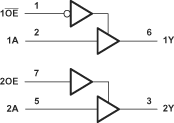SCES210P April 1999 – January 2019 SN74LVC2G241
PRODUCTION DATA.
- 1 Features
- 2 Applications
- 3 Description
- 4 Revision History
- 5 Pin Configuration and Functions
- 6 Specifications
- 7 Parameter Measurement Information
- 8 Detailed Description
- 9 Application and Implementation
- 10Power Supply Recommendations
- 11Layout
- 12Device and Documentation Support
- 13Mechanical, Packaging, and Orderable Information
Package Options
Refer to the PDF data sheet for device specific package drawings
Mechanical Data (Package|Pins)
- DCU|8
- YZP|8
- DCT|8
Thermal pad, mechanical data (Package|Pins)
Orderable Information
3 Description
This dual buffer and line driver is designed for 1.65-V to 5.5-V VCC operation.
The SN74LVC2G241 device is designed specifically to improve both the performance and density of 3-state memory-address drivers, clock drivers, and bus-oriented receivers and transmitters.
NanoFree package technology is a major breakthrough in IC packaging concepts, using the die as the package.
The SN74LVC2G241 device is organized as two 1-bit line drivers with separate output-enable (1OE, 2OE) inputs. When 1OE is low and 2OE is high, the device passes data from the A inputs to the Y outputs. When 1OE is high and 2OE is low, the outputs are in the high-impedance state.
To ensure the high-impedance state during power up or power down, OE should be tied to VCC through a pullup resistor, and OE should be tied to GND through a pulldown resistor; the minimum value of the resistor is determined by the current-sinking or the current-sourcing capability of the driver.
This device is fully specified for partial-power-down applications using Ioff. The Ioff circuitry disables the outputs, preventing damaging current backflow through the device when it is powered down.
Device Information(1)
| PART NUMBER | PACKAGE | BODY SIZE (NOM) |
|---|---|---|
| SN74LVC2G241DCT | SM8 (8) | 2.95 mm × 2.80 mm |
| SN74LVC2G241DCU | VSOOP (8) | 2.30 mm × 2.00 mm |
| SN74LVC2G241YZP | DSBGA (8) | 1.91 mm × 0.91 mm |
- For all available packages, see the orderable addendum at the end of the data sheet.
Logic Diagram (Positive Logic)
